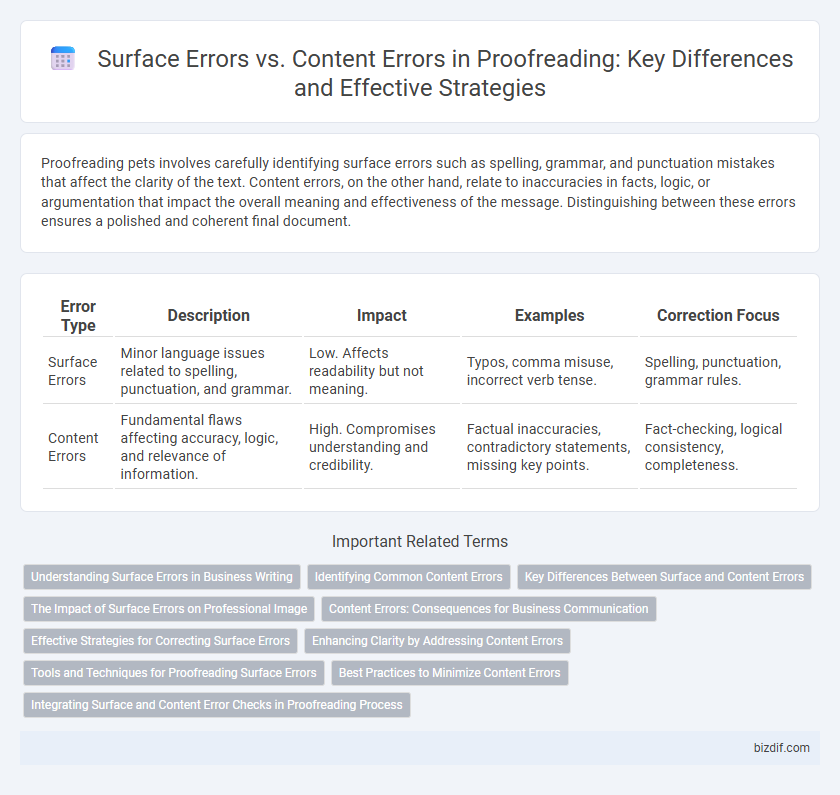Proofreading pets involves carefully identifying surface errors such as spelling, grammar, and punctuation mistakes that affect the clarity of the text. Content errors, on the other hand, relate to inaccuracies in facts, logic, or argumentation that impact the overall meaning and effectiveness of the message. Distinguishing between these errors ensures a polished and coherent final document.
Table of Comparison
| Error Type | Description | Impact | Examples | Correction Focus |
|---|---|---|---|---|
| Surface Errors | Minor language issues related to spelling, punctuation, and grammar. | Low. Affects readability but not meaning. | Typos, comma misuse, incorrect verb tense. | Spelling, punctuation, grammar rules. |
| Content Errors | Fundamental flaws affecting accuracy, logic, and relevance of information. | High. Compromises understanding and credibility. | Factual inaccuracies, contradictory statements, missing key points. | Fact-checking, logical consistency, completeness. |
Understanding Surface Errors in Business Writing
Surface errors in business writing include spelling mistakes, punctuation errors, and grammar issues that affect the clarity and professionalism of documents. These errors can undermine the credibility of the message even when the content is accurate and well-structured. Identifying and correcting surface errors ensures effective communication and maintains the trust of clients and stakeholders.
Identifying Common Content Errors
Common content errors in proofreading include inconsistencies in facts, logical fallacies, and unclear or misleading information that impacts the overall message. Misinterpretations of data, incorrect terminology, and contradictions within the text often disrupt coherence and credibility. Identifying these content errors requires careful analysis beyond grammar and spelling, focusing on the accuracy and relevance of the material presented.
Key Differences Between Surface and Content Errors
Surface errors involve mistakes in spelling, punctuation, and grammar that affect the readability of a text without altering its meaning. Content errors relate to inaccuracies in facts, logic, or overall message that compromise the credibility and coherence of the work. Identifying these distinct error types is crucial for effective proofreading and improving both clarity and accuracy in written communication.
The Impact of Surface Errors on Professional Image
Surface errors, such as spelling mistakes, punctuation errors, and typographical slips, significantly undermine the professional image of a document by conveying carelessness and lack of attention to detail. These errors can distract readers from the core message, reducing the credibility and perceived expertise of the author or organization. Maintaining a polished, error-free presentation enhances trust, authority, and the overall effectiveness of professional communication.
Content Errors: Consequences for Business Communication
Content errors in business communication can lead to misunderstandings, misinterpretations, and potential financial losses by conveying inaccurate or incomplete information. These mistakes undermine the credibility of the organization and disrupt decision-making processes. Clear, precise content is essential to maintain professionalism and ensure effective communication with clients, partners, and stakeholders.
Effective Strategies for Correcting Surface Errors
Effective strategies for correcting surface errors in proofreading include systematically checking for spelling, punctuation, and grammar mistakes to enhance clarity and professionalism. Utilizing tools such as spell checkers and grammar software complements manual review by catching overlooked typographical errors. Maintaining consistent formatting and style guides further ensures surface-level accuracy without altering the overall content meaning.
Enhancing Clarity by Addressing Content Errors
Addressing content errors is crucial for enhancing clarity, as these errors affect the accuracy and coherence of the message, unlike surface errors that primarily involve grammar and spelling. Focusing on content errors ensures the logical flow, consistency, and relevance of information, which improves overall comprehension. Effective proofreading targets these deeper issues to deliver a clear and precise text that meets the intended purpose.
Tools and Techniques for Proofreading Surface Errors
Tools like spell checkers, grammar checkers, and style guides are essential for identifying surface errors such as typos, punctuation mistakes, and incorrect word usage. Techniques including reading aloud, using digital annotation tools, and employing checklists help ensure a thorough review of surface-level issues without altering the content's meaning. Leveraging software with AI-powered proofreading capabilities enhances the detection of subtle surface errors, improving overall document accuracy and readability.
Best Practices to Minimize Content Errors
To minimize content errors during proofreading, prioritize thorough fact-checking and cross-referencing information with reliable sources. Employ a structured review process that includes multiple passes focusing separately on facts, consistency, and overall clarity. Utilize digital tools designed for content validation alongside manual review to ensure accuracy and coherence.
Integrating Surface and Content Error Checks in Proofreading Process
Integrating surface and content error checks in the proofreading process enhances overall text quality by addressing both grammatical inaccuracies and contextual inconsistencies. Surface error checks focus on spelling, punctuation, and syntax, while content error checks ensure logical flow, factual accuracy, and coherence. Combining these methods creates a comprehensive review strategy that minimizes errors and improves clarity and reliability in written communication.
surface errors vs content errors Infographic

 bizdif.com
bizdif.com